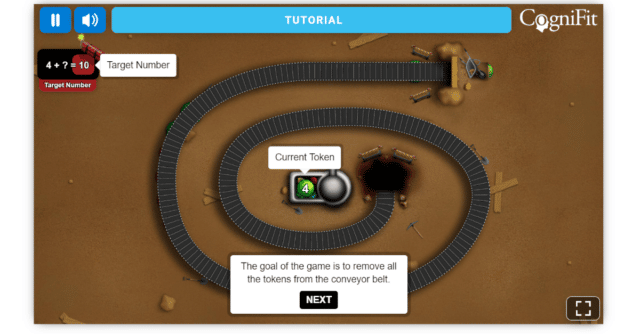
Number Lines Game – Work Your Short-Term Memory
Number Lines might look familiar. That’s because there are a million versions on the app store – all offering some sort of paid upgrade to make your leveling easier with big, flashy lights and impressive graphics.
But that’s not the case with the CogniFit version.
As with all the brain games you find here, they have been created from original ideas or adapted from existing ones to focus on improving cognitive processing. Today, let’s take a look at Number Lines, how to play it, how it’s different, and what processes you’ll exercise.
How To Play Number Lines
- The row of shapes will start slowly feeding out of a hole in the ground. On some levels, the shapes might be the same. On others, they might be different – like circles, squares, and triangles. In the middle of each shape is a number.
- In the middle of the play area is a cannon with a single number. Just move the mouse and click it to shoot the number wherever you want.
- In the top left corner, there will be a number highlighted in red. This is your “target” number.
The goal of the game is to shoot the number in your cannon to land beside numbers in the moving string so they equal the target number. For example, if your target is “10” and you have a “6” loaded in your cannon, you would want to shoot it beside a “4.” Keep doing this until the entire line is cleared and the level is complete.
Easy, right?
Weeeelllll…..
As with all CogniFit games, things start out easy (the brain can’t be overwhelmed too fast because it won’t help with cognitive improvement). The aim is to play 20 minutes of games three times a week and you’ll notice improvements. This is why the games can increase in difficulty – because you’re creating new neural networks.
So, as Number Lines gets harder, the number in the cannon will quickly disappear (so you’ll be forced to remember it), lines move faster, and tracks become more complicated to find a way to shoot your shape to your target number.

How Number Lines Is Different
The versions you see on the app stories are really meant to be additive distractions and pay drains. There are only color or shape combinations and the reliance on advancing comes from gimmicks.
CogniFit’s adaption uses simple math (but in a challenging way), altered tracks that make you plan ahead, and disappearing numbers that all force the player into flexing the following cognitive abilities…
What Do You Improve?
Processing Speed
This cognitive ability is really just a fancy way of saying how long it takes someone to do a mental task. It’s the time between getting the information (visual, audio, movement) and how you react.
However, even though, “Processing speed is one of the main elements of the cognitive process, which is why it is one of the most important skills in learning, academic performance, intellectual development, reasoning, and experience” it’s not actually related to intelligence. It can be related to listening, taking notes, holding a conversation, etc.
Think of Processing Speed as more of efficiency in recalling what you’ve learned and how you think.
Visual Scanning
“Visual scanning is the ability to efficiently, quickly, and actively look for information relevant to your environment. It is what makes it possible to find what you’re looking for using just your vision. Visual scanning is an important skill for daily life, and makes it possible to efficiently carry out a number of different tasks.”
To do this kind of scanning we have to first be aware of the stimuli we want to find. Next, we need to have the ability to distinguish what we are looking for compared to other things in the environment. For example, a set of keys versus a pair of shoes. After that, we need to “recognize” it. Finally, we have to use our field of view (including our peripheral) to find what we are looking for.
All this happens in milliseconds. But, if any of these processes are altered or damaged, we wouldn’t be able to find what we are looking for.

Short-Term Memory
This one is pretty easy. But it’s also surprising.
Lots of people worry about their short-term memory. They think that because they forget something quickly, there is a problem. But did you know that it’s supposed to be that way?
For example, if you are asked to remember a sequence of 10 digits, you’ll likely be able to remember between 5 and 9 numbers. This is because the amount of information short-term is able to retain is 7 elements, with a variation of 2, either more or less. Also, we can really only retain information here for about 30 seconds. After that, it needs to be forgotten or through the process that ends up in our long-term memory.
You can improve your short-term memory (like when someone gets older). There are also tricks that might let you add a few more elements or a few more seconds. But people who can “remember everything” and memory palaces” are more of a rare phenomenon than anything.
All this being said, it’s still a great cognitive skill to train because it goes hand-in-hand with learning and long-term memory.
Number Lines Conclusion
This is quite a fun game that can be as simple or as complicated as you want. It’s also a good one to add into your brain training if you want to focus on a memory regime. And remember, all you need are three training sessions per week of 20 minutes to start seeing a difference.
If you want to know more, you can go to CogniFit.com.












